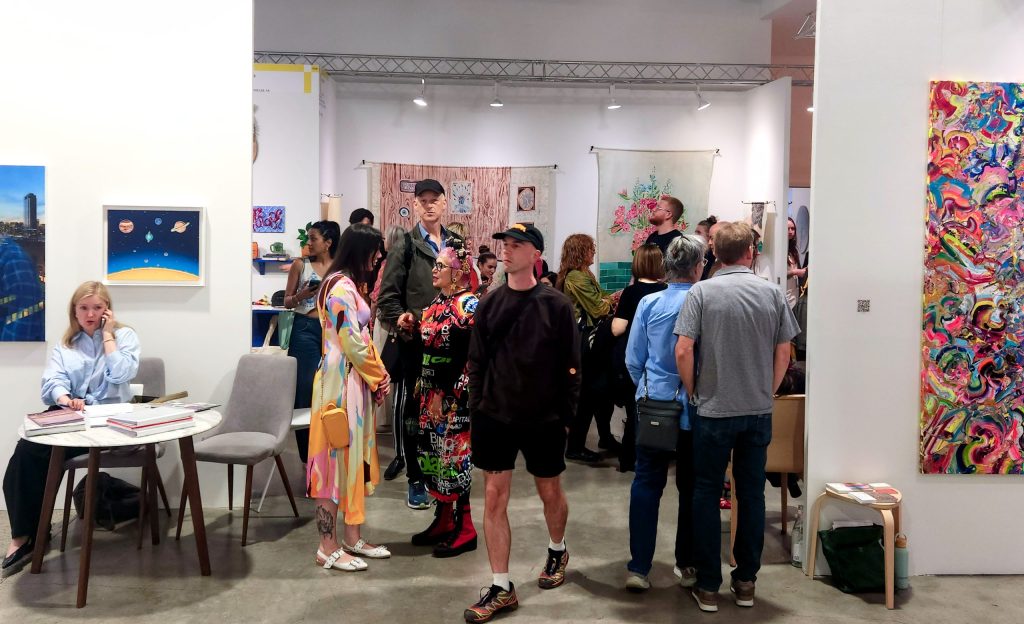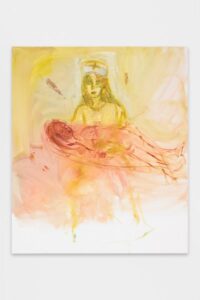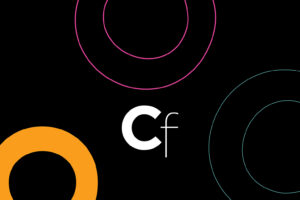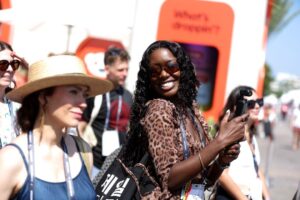Future Art Fair Enters Its Grown-Up Era


Given the trials and tribulations of the art market right now, why would dozens of galleries put their faith in an art fair that only sprouted in the last decade? That’s what I set out to find out at New York’s Future Fair, which returned this week to the Chelsea Industrial space for its fifth edition, on view through Saturday, May 10. Having launched in the choppy waters of the COVID-19 pandemic, Future has since nestled into Frieze Week with a continuously expanding participant list — this year, there’s a lineup of 69 domestic and international exhibitors.
At its inception, fair co-founders Rebeca Laliberte and Rachel Mijares Fick pledged to divvy up 35% of the profits between the founding galleries for the first five years of its run. Starting this year, Future has pivoted to the Pay-It-Forward fund, through which 15% of the profits will be allocated as grants to “rising art dealers” participating in the exhibition. (It’s unclear how many dealers will receive the grant or what the criteria for selection is, but I reached out to the fair with an inquiry.)

Few, if any, of the fair’s founding galleries were participating in the 2025 edition. Elijah Wheat Showroom in Newburgh, from the inaugural cohort, returned for the fifth consecutive year with a joint display of Chicago Imagist Julia Schmitt Healy and egg tempera painter E.E. Kono.
“As we considered our initial participation in Future Fair, we were attracted to both it being women-owned and -operated, along with their idea of promoting a new way of co-owning while sharing the proceeds,” gallery co-founder Carolina Wheat-Nielsen elaborated in an email.
“I looked around on VIP night and realized [there were] varied cultural identities, underdogs, and more maligned populations around me joyously admiring and consuming the diverse art,” Wheat-Nielsen continued. “Subsidies, and other gifts helped first-time dealers present work from artists at lower price-points, and thereby changing who could get off the bench and get into the game.”
Among the newer participants, several remarked to Hyperallergic that they were attracted to the fair’s scale, its platform for young and emerging galleries, and its evolving curatorial vision — this year’s organizing team consisted of PPOW Director Eden Deering, independent curator and historian Margarita Rosa, and Public Art Fund Associate Curator Jenée-Daria Strand.

Patricia Trafton, owner and director of Soapbox Arts in Burlington, Vermont, told me that this was her first time at Future. Her display consisted of Athena Petra Tasiopoulos’s hand-etched encaustic panels, Katrine Hildebrandt-Hussey’s mixed-media examinations of sacred geometry, and Krista Mezzadri’s gesture-heavy mounted monotypes.
“I opened the gallery in 2019, so it took several years for me to be able to get involved with these fairs and open myself up to a market that wasn’t otherwise available to me because of our location,” Trafton said. She added that she specifically chose Future after noticing that it received lots of press in its early iterations, and for the prominence of emerging dealers and art spaces that participate.


LaiSun Keane, who opened her Boston-based namesake gallery during the pandemic itself, returned to Future for her second year with a solo presentation of ceramic tiles and standalone vessels by Raina Lee — all inspired by Lee’s travels across Spain.
Keane mentioned to me that the fair has sharpened its vision after the trial-and-error growing pains of debuting during the global health emergency. “I really can appreciate its growth, and I honestly see it as a direct competitor to NADA — if not better, since there’s less of the ‘elitist’ exclusivity to [Future],” she remarked.
Also new to Future, and to New York in general, is three-month-old Chelsea gallery GOCA by Garde, which currently specializes in contemporary Japanese output and brought multi-colored work by Aya Kawato and Yuta Okuda to its white-walled booth.
“Our key initiative right now is to bring Japanese art to an international market, and we were invited by Future’s leaders to participate in the fair this year,” Akinori “Aki” Okada, the gallery’s CEO and creative director, told me. “This fair is very unique.”

With regards to entering the American art market in such an unstable time, Okada said that the gallery is “taking things day-by-day.”
“We got our first shipment of work from our artists about a month ago, so we were ahead of curve in terms of the tariffs situation at least,” he explained. “We’ll see how things go …”
Additional standouts include the display of Larissa De Jesus Negrón’s luscious paintings from Puerto Rico’s Sabroso Projects, Sarah Cohen’s near-translucent oil compositions on canvas through NYC-based Hyacinth Gallery, and Alexandra Levasseur’s oil, gouache, and enameled stoneware compositions via Galerie C.O.A. from Montréal. As it stands in its fifth year, Future Fair is well-attuned to what’s needed right here, right now.








